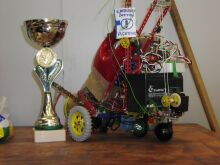Clara
the easiest way to build a robot
Clara is a robot (I should say: “Clara was a robot”, because it has been already taken apart) built completely from Merkur (Czech version of Meccano). It was built for the Eurobot 2002 competition, and it was the very first robot The Short Circuits team put together. The goal was to show that even with minimal resources like Merkur you can still build a robot, which can compete at an international competition. Clara has won the Creativity / Innovation prize at the Eurobot 2002 competition.
Quick Info
Body made of Merkur contruction set,
two 12V Maxon motors with gear-boxes, Hitachi H8/3048 microprocessor,
CNY70 sensors for the line detection, vacuum cleaner to pick up the balls, simple
software tailored especially for the Eurobot 2002
competition.
Hardware
Clara had some parts borrowed from sponsoring company
Haptica:
two 12V Maxon motors with gear-boxes, and control board based on Hitachi H8/3048
microprocessor. Note, that there was no need for speed control because the
motors were relatively strong and Clara was moving rather slow (approximately
0.15m/s).
We were using CNY70 sensors for the line detection, which worked fine on
previous robot Alena
in 2001 (again Eurobot contest). Unfortunately they behaved
quite differently on the dark green surface, when compared to the black playing
field in 2001. The H8 used analog inputs to get the readings, and the
thresholding (white line/green field) was done afterward in software. A short
calibration routine, using combination of pressed microswitches, preceded every
match. There were three CNY70 sensors (in original spec there was a 4th one for
ball color detection, but it was not needed): two in the middle for line
following, and one on the side for counting the number of crossings.
A vacuum cleaner was used for picking the balls. We bought it for the next
contest (robot cleaning contest in Switzerland), but it turned out to be quite
useful for Eurobot 2002. It attracted a lot of attention and as a result we
received the Innovation price for it. The vacuum cleaner was possible to turn on
& off via relay (switched through Darlington array).
Microswitches were used on several places: detection of arm reaching the end
point, detection of collision with the pocket, detection of low position and
finally detection of ball sucked by the vacuum cleaner.
The last component was a modified servo with removed potentiometer and
mechanical limits. It was used for pulling up the arm with a ball. The servo was
controlled directly from H8 by square logic signal.
Software
Program was written in embedded C for H8. We tried to make it as simple as
possible and it resulted in to a small state machine:
- turn on vacuum cleaner and wait 0.5 second
- follow the line and count number of crossings
- if ball detected pull up arm to upper position (determined by limit switch)
- on 9th crossing turn left
- if collision with a pocket turn of the vacuum cleaner
This way we were able to pick the first red ball in front of the starting
area and carry it to the correct pocket. The original code was actually slightly
more complicated – after step 5 Clara was supposed to back up, move arm down,
and move “randomly” in the field, searching for more balls. But as
expected, there were problems so we end up with only the first part of the
program. One of problems was, that servo started to turn one way only (up), and
there was absolutely no time to find out, what is going on [later we found a bad
solder joint on the modified potentiometer]. Other problems were related to the
line detection and blockage caused with many balls under the arm.
Results
Clara finished at 17th place. It was very unfortunate position, because only
16 teams were selected to finals. It was a little bit more emotional, because
we were posted as 16th team due to a mistake (team from Finland was missing on
the list), and we learned about the mistake just a couple minutes before
“the big show”… On the other hand we won the Creativity price,
which is probably the best we could hope for :).
If you have found this robot interesting or if you are missing some information
you can contact us through the
feedback form
and we will be more than happy to satisfy your curiosity .
People
| Martin Dlouhý (md) | team leader, SW, testing |
| Jan Hradil (jhr) | vacuum cleaner "hand", electronics & mechanics |
| Ludvík Tesař (ludvik) | complete rebuild of merkur base, electronics |
| Bernard Michael Tyers | |
| Derek Cassidy |
Funding
Robot Clara was built from private resources of the team members with the support
of an Irish R&D company Haptica who loaned
the Maxon motors and the H8 mainboard.
